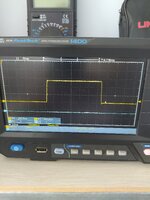DM0119
Junior Member level 1

Is this curve of the rise in a mosfet,acceptable to work in a H bridge?
Something stops the rise for 40ns at about 4,5 volts.
What should be causing this phenomenon?

Something stops the rise for 40ns at about 4,5 volts.
What should be causing this phenomenon?


